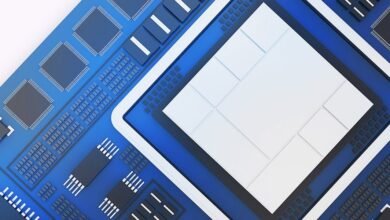
▼ Summary
– Quantum computing is advancing rapidly, using qubits to solve complex problems far beyond traditional computers’ capabilities, with applications in medicine and cryptography.
– AI and machine learning are now mainstream, enabling pattern recognition, decision-making, and generative content creation, raising ethical and privacy concerns.
– Edge computing processes data locally, reducing delays for IoT devices like smart cities and autonomous vehicles, enabling real-time responses.
– Cloud computing is evolving with hybrid/multi-cloud strategies, AI integration, and serverless options, alongside a focus on energy efficiency.
– The digital revolution presents challenges, including security risks, workforce transformation, and environmental impacts, requiring responsible adoption.
Introduction: A Digital World Reimagined
Remember when computers were just big boxes on a desk? Well, those days are long gone. We’re now living through a quiet revolution, a new age of computing that’s changing everything around us. It’s not just about faster processors or bigger screens; it’s about a fundamental shift in how technology works and how it fits into our lives.
This isn’t some far-off future. It’s happening right now, shaping everything from how we work and learn to how we connect with each other. Think of it as a massive upgrade to our digital world, making it smarter, more connected, and more responsive than ever before. This article will explore the key technologies driving this change and what they mean for you.
Quantum Leaps: The Power of the Unseen
Imagine a computer that can solve problems so complex, today’s most powerful machines would take billions of years to even scratch the surface. That’s the promise of quantum computing. Unlike regular computers that use bits (which are either a 0 or a 1), quantum computers use ‘qubits’ that can be both 0 and 1 at the same time. This allows them to process vast amounts of information simultaneously, opening doors to breakthroughs in medicine, materials science, and even cracking unbreakable codes.
While still in its early stages, quantum computing is rapidly advancing. Researchers are building more stable and powerful quantum machines, and we’re seeing the first real-world applications emerge. It’s a field that’s moving incredibly fast, and its impact will be felt across countless industries.
The Brains Behind the Machines: Artificial Intelligence and Machine Learning
Artificial Intelligence (AI) and Machine Learning (ML) are no longer just science fiction. They’re everywhere, from the recommendations you get on streaming services to the facial recognition on your phone. These technologies allow machines to learn from data, recognize patterns, and even make decisions.
One of the most exciting recent developments is ‘Generative AI,’ which can create entirely new content. This means AI can now write articles, compose music, design images, and even generate code. Beyond creative tasks, AI is also becoming ‘agentic,’ meaning it can plan and carry out complex tasks on its own. This has huge implications for everything from healthcare diagnostics to autonomous vehicles. Of course, with such powerful tools come important questions about privacy, fairness, and how we ensure these technologies are used responsibly.
Closer to the Action: Edge Computing and the Internet of Things
Think about how much data is generated every second by our phones, smart homes, and countless sensors. Sending all that data to a central cloud server for processing can be slow. That’s where ‘edge computing’ comes in. It’s about processing data closer to where it’s created, right at the ‘edge’ of the network. This dramatically reduces delays and makes real-time responses possible.
Edge computing works hand-in-hand with the ‘Internet of Things’ (IoT), which is the vast network of interconnected devices that collect and exchange data. From smart city sensors managing traffic to industrial machines optimizing production, edge computing allows these IoT devices to react instantly, making our environments smarter and more efficient. This technology is crucial for applications where every millisecond counts, like self-driving cars and remote surgery.
The Ever-Expanding Cloud: More Than Just Storage
Cloud computing has become a cornerstone of our digital lives, providing on-demand access to computing power and storage over the internet. But the cloud is evolving beyond simple data storage. We’re seeing a rise in ‘hybrid and multi-cloud’ strategies, where organizations use a mix of different cloud providers and their own private data centers for greater flexibility and resilience.
AI is also deeply integrated into cloud platforms, offering powerful AI capabilities as services that businesses can easily tap into. ‘Serverless computing’ is another trend, where developers can build and run applications without having to manage the underlying servers. This makes development faster and more efficient. There’s also a growing focus on ‘green computing,’ ensuring that these massive cloud infrastructures operate as energy-efficiently as possible.
Looking Ahead: Opportunities and Challenges
The new age of computing promises incredible advancements, but it also brings important questions and challenges. As technology becomes more intertwined with our lives, we need to address concerns about data privacy, algorithmic bias, and the potential for a ‘digital divide’ where some are left behind.
Security is another major concern, with new threats emerging from AI-powered attacks and the need for ‘quantum-resistant cryptography’ to protect our data from future quantum computers. The workforce will also transform, requiring new skills and creating new job opportunities while potentially displacing others. Finally, the environmental impact of all this computing power is a critical consideration, pushing for more sustainable solutions.
Conclusion: Shaping Our Digital Future
The new age of computing is not just a collection of new technologies; it’s a fundamental shift in how we approach problems and create solutions. The convergence of quantum computing, AI, edge computing, and the evolving cloud is creating a powerful ecosystem that will reshape industries and redefine what’s possible.
While challenges remain, the opportunities are immense. By understanding these shifts, we can better prepare for the future, harness the power of these technologies responsibly, and work towards a digital future that benefits everyone. The journey has just begun, and it promises to be an exciting one.


